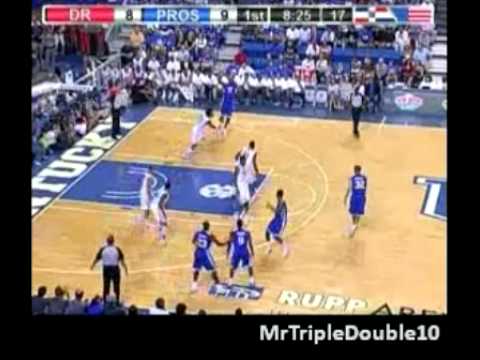Can the Gonzaga big man crack the lottery in on June 24?
30 years ago, the Portland Trail Blazers used the last pick of the first round on a center that could transcend the game of basketball in the Pacific Northwest. His name? Arvydas Sabonis.
Of course it would take 10 years for ‘Sabas’ to make his way to the NBA, where he made he debut at age 31 in Portland. Other than the boos from the nursing home in Portland (side note – why did the NBA choose this location to shoot a live reaction from?), Sabonis is widely regarded as a terrific selection by the Blazers. He played a key role in Rip City from 1995-2001, serving as a double-double player and one of the team’s best passers during his top years with the Blazers.
30 years after the Lithuanian’s selection, another familiar name should be heard in the first round on June 24. Gonzaga big man Domantas Sabonis, the son of Arvydas, entered the draft following his sophomore year at Gonzaga, and is widely projected as a top-20 pick. How high can he go?
It is not difficult to watch Sabonis play and see flashes of his dad. Sabonis is a high-efficiency player who excels as a low post scorer and rebounder. He is also a more-than-capable passer that can step out and hit a mid-range jump shot.
Sound familiar?
Born in Portland during Arvydas’ second season with the Blazers, Sabonis returned to the Pacific Northwest to play for Mark Few’s Gonzaga Bulldogs beginning in the 2014-15 season. He broke through a crowded frontcourt to earn minutes, and posted averages of 17.6 points and 11.8 rebounds over 31.8 minutes per game as a sophomore while shooting 61.1 percent from the floor. His second-year player efficiency rating came in strong at 29.3.
His production on the floor extends to the international level, where Sabonis has been a mainstay for Lithuania’s youth national teams. This past summer, Sabonis competed at the U20 European-A Championships, where he averaged 11.5 points, 13.2 rebounds and 2.0 assists per game, helping Lithuania place seventh overall. He was the tournament’s leading rebounder, and had one game (against Ukraine) where he hauled in 28 boards.
Sabonis’ key strengths are his ability to mix it up in the paint to both grab rebounds and score at the rim. Left-handed, he has a soft touch around the hoop and he likes to finish with a jump hook over his right shoulder. He is also adept at mixing in a series of ball fakes to create for himself and teammates.
He has a high basketball IQ, and always seems to be positioned correctly. Coupled with a very good motor, Sabonis becomes a legitimate threat on the boards and in transition.
Away from the rim, Sabonis has shown an improved ability to knock down jump shots. While he mechanics are not exactly fluid, he knocked down five of 14 3-point attempts and 22 of 45 jumpers during the season. He has a very rigid base in his jump shot, and should be able to extend his range once his legs lose some stiffness.
Shifting to Sabonis’ weaknesses, the left-hander will get penalized most for his lack of great athleticism. He is generally a below-the-rim player who will not blow past a defender or out jump an opponent for a rebound. He does his work in the trenches, using his core strength and positioning to get to the ball first or force an opponent into a foul. Competing against NBA-caliber athletes on a nightly basis, will Sabonis see the same success as in college? It’s a more-than-fair question to consider.
Similarly, Sabonis punished smaller and similarly athletic defenders at Gonzaga to score in the post. Some of the looks he was able to create simply will not be as prevalent at the next level due to his lack of elite athletic tools.
At 6-10, Sabonis has the NBA body to play both the power forward and center positions, but his wingspan is only slightly longer at 6-10.5. Sabonis is not a shot blocker by any means, as he averaged only 0.6 per game in Spokane.
Finally, Sabonis is decently quick for the position, but as more teams shift to a four-out offense on a more regular basis, questions should be asked about his ability to defend more athletic players on the perimeter.
Sabonis has the tools to become a starter in the NBA, and should see a range of 12-20 on draft night. His game is comparable to Bulls forward Taj Gibson and, perhaps generously, Magic center Nikola Vucevic. The 17th-ranked player on my latest Big Board, Sabonis was slotted to the Pistons at No. 18 overall in my May 28 update of The Lottery Mafia mock draft.
Around the web, Sabonis is slotted 18th by DraftExpress, 20th by ESPN and 12th and 16th by CBS Sports’ Sam Vecenie and Gary Parrish, respectively. There are many center-hungry teams picking in the late lottery, and it is not a reach to think his ceiling is No. 10 with Milwaukee.
Teams choosing Sabonis will get a player that can make an impact in the rotation right away, but his ceiling as that of a lower-end starter could drive his stock towards the late teens where Boston, Detroit and Denver will undoubtedly show interest.
Baby Sabonis may not ever become the generational talent that his father was, but he has the ability and feel for the game to make a difference for an NBA contender.
Who wants to take the shot?
Add The Sports Daily to your Google News Feed!
